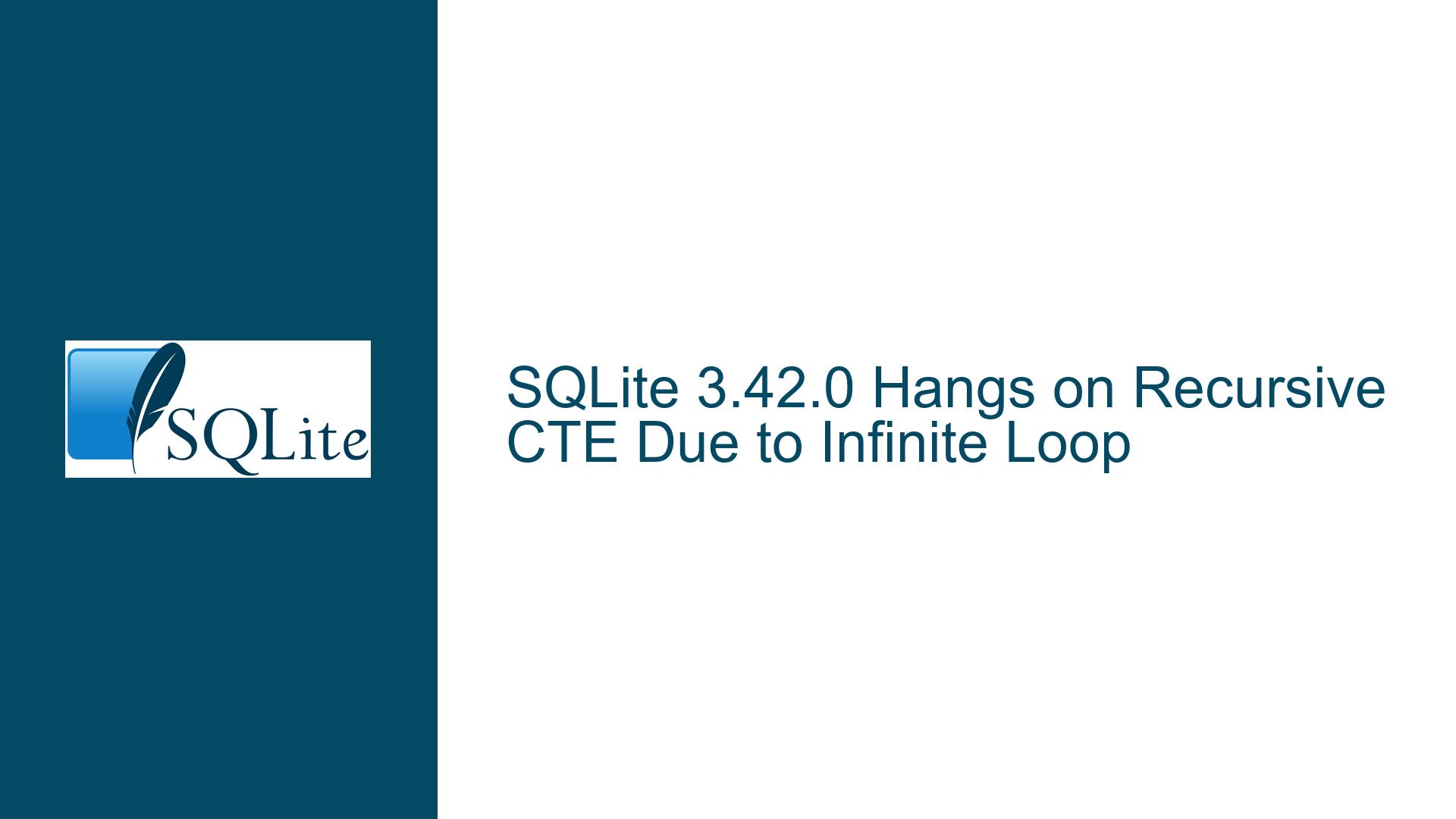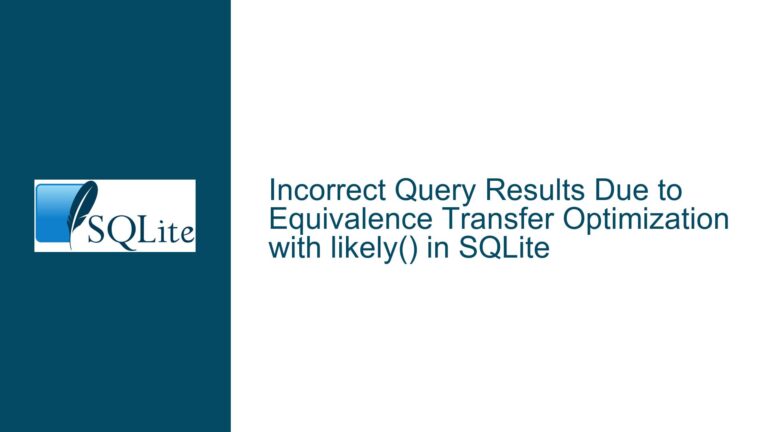SQLite 3.42.0 Hangs on Recursive CTE Due to Infinite Loop
Understanding the Infinite Loop in Recursive CTE Queries
The core issue in this scenario revolves around a recursive Common Table Expression (CTE) in SQLite that enters an infinite loop, causing the query to hang indefinitely. Recursive CTEs are powerful tools for hierarchical or iterative data processing, but they come with the risk of infinite recursion if not carefully designed. In this case, the recursive CTE q12 is the culprit, as it repeatedly joins with a row in q11 that creates a never-ending cycle. The root cause lies in the data inserted into t1, specifically the row (-1, 32, 32), which sets up a recursive relationship that the query cannot resolve.
The problem is exacerbated by the complexity of the query, which involves multiple CTEs, joins, and window functions. While the query appears to be logically sound at first glance, the data dependencies and recursive logic create a situation where the query planner cannot optimize the execution to avoid the infinite loop. This highlights the importance of understanding both the data and the recursive logic when working with recursive CTEs in SQLite.
Identifying the Root Cause of the Infinite Recursion
The infinite recursion in this query is caused by the interaction between the recursive CTE q12 and the data in t1 and t2. Specifically, the row REPLACE INTO t1 VALUES (-1, 32, 32); creates a self-referential relationship that the recursive CTE cannot escape. Let’s break down the critical components:
Recursive CTE
q12Definition:q12(c0,c1) AS ( SELECT *,1 FROM q8 UNION SELECT pr.c1, an.c1+1 FROM q12 an JOIN q11 pr ON an.c0 = pr.c0 WHERE pr.c1 NOT NULL )This CTE starts with a base case from
q8and then recursively joins withq11to produce new rows. The recursive step increments thec1value by 1 for each iteration.Data in
q11:SELECT * FROM q11; c0|c1 31|32 32|32The row
(32, 32)inq11creates a problem because it matches the recursive join conditionan.c0 = pr.c0and produces a new row(32, 33)in the next iteration. This process repeats indefinitely because thec0value remains32, and thec1value keeps incrementing.Data in
t1:REPLACE INTO t1 VALUES (-1, 32, 32);This row is the source of the issue. It creates a relationship where
f2 = 32andf3 = 32, which feeds into the recursive CTE logic and causes the infinite loop.
The combination of these factors results in a query that never terminates because the recursive logic cannot break out of the cycle created by the data.
Resolving the Infinite Loop and Optimizing the Query
To fix the infinite loop and ensure the query executes correctly, we need to address both the data and the recursive logic. Here are the steps to resolve the issue:
Modify the Data to Break the Cycle:
The root cause of the infinite loop is the row(-1, 32, 32)int1. Removing or modifying this row will prevent the recursive CTE from entering an infinite loop. For example:DELETE FROM t1 WHERE f1 = -1 AND f2 = 32 AND f3 = 32;Alternatively, you can modify the row to break the cycle:
REPLACE INTO t1 VALUES (-1, 32, NULL);This change ensures that the recursive CTE does not produce an infinite sequence of rows.
Add a Termination Condition to the Recursive CTE:
To prevent similar issues in the future, you can add a termination condition to the recursive CTE. For example, you can limit the recursion depth by adding a condition to stop after a certain number of iterations:q12(c0,c1) AS ( SELECT *,1 FROM q8 UNION SELECT pr.c1, an.c1+1 FROM q12 an JOIN q11 pr ON an.c0 = pr.c0 WHERE pr.c1 NOT NULL AND an.c1 < 100 -- Limit recursion depth )This ensures that the recursive CTE stops after 100 iterations, even if the data would otherwise cause an infinite loop.
Optimize the Query Structure:
The query can be further optimized by breaking it into smaller, more manageable parts. For example, you can materialize intermediate results using temporary tables or subqueries to reduce the complexity of the recursive CTE. This approach also makes it easier to debug and understand the query logic.Use Indexes to Improve Performance:
Ensure that the tablest1andt2have appropriate indexes to speed up the joins and recursive operations. For example:CREATE INDEX idx_t1_f2 ON t1(f2); CREATE INDEX idx_t2_f4 ON t2(f4);These indexes can significantly improve the performance of the query by reducing the time required for join operations.
Test with Smaller Datasets:
Before running the query on the full dataset, test it with a smaller subset of data to ensure that the recursive logic works as expected. This approach helps identify potential issues early and reduces the risk of running into performance problems or infinite loops.
By following these steps, you can resolve the infinite loop issue and optimize the query for better performance and reliability. The key is to carefully analyze the data and the recursive logic to ensure that the query terminates correctly and produces the desired results.
In conclusion, recursive CTEs are powerful tools in SQLite, but they require careful design and testing to avoid issues like infinite loops. By understanding the data dependencies, adding termination conditions, and optimizing the query structure, you can harness the full potential of recursive CTEs while avoiding common pitfalls.






